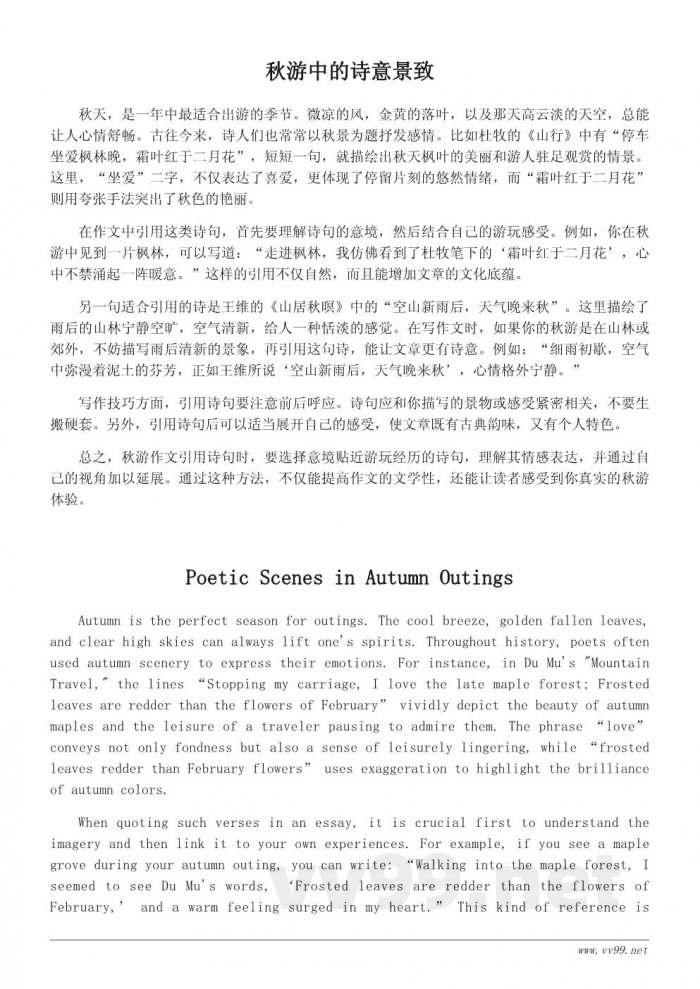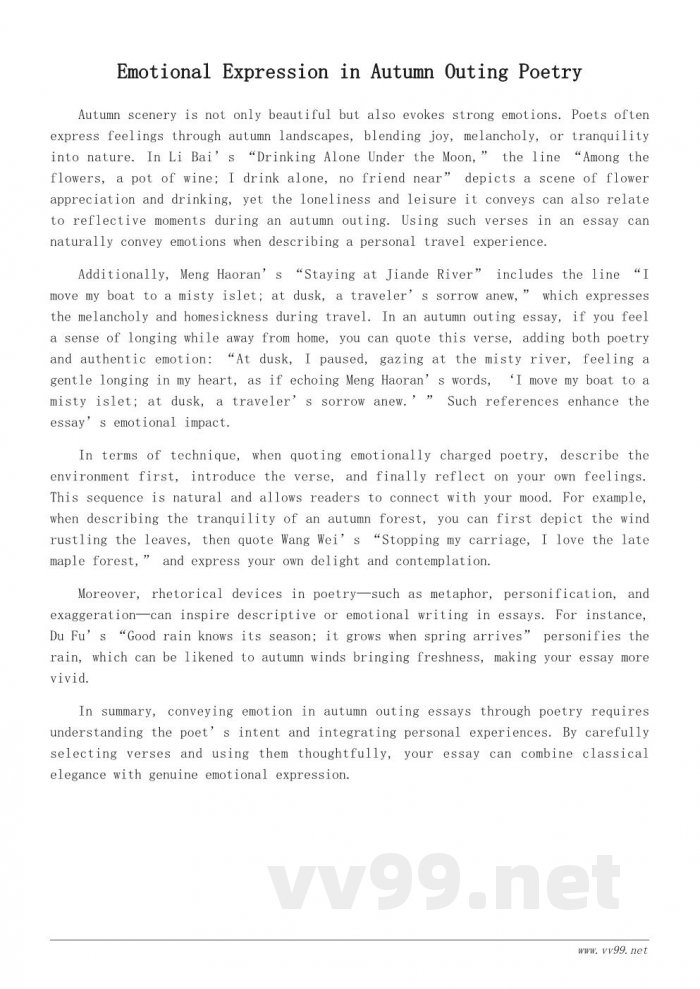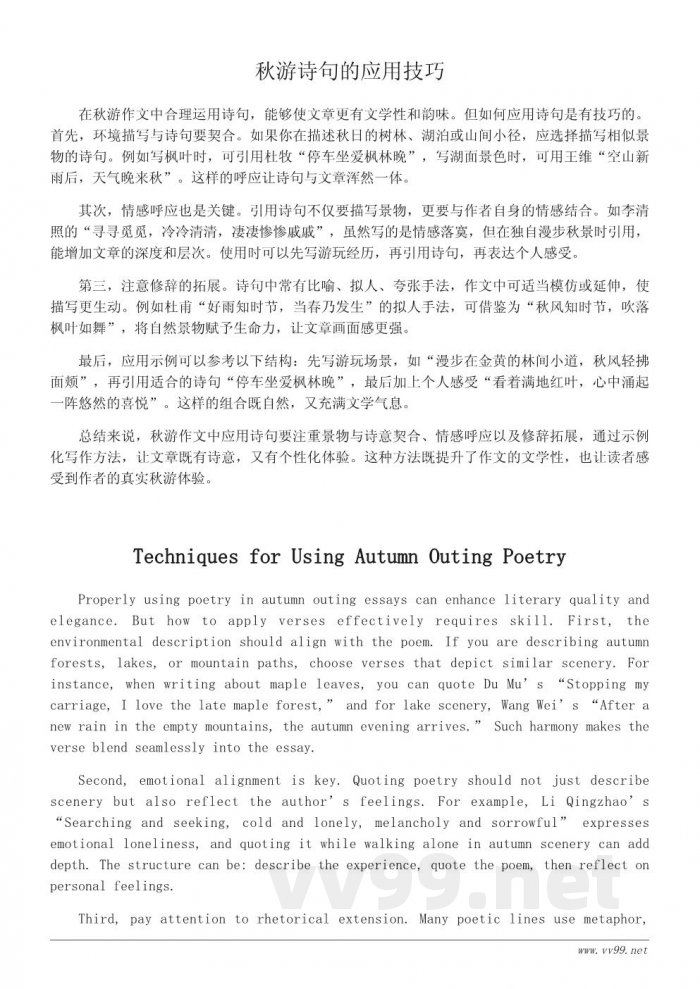秋游中的诗意景致
秋天,是一年中最适合出游的季节。微凉的风,金黄的落叶,以及那天高云淡的天空,总能让人心情舒畅。古往今来,诗人们也常常以秋景为题抒发感情。比如杜牧的《山行》中有“停车坐爱枫林晚,霜叶红于二月花”,短短一句,就描绘出秋天枫叶的美丽和游人驻足观赏的情景。这里,“坐爱”二字,不仅表达了喜爱,更体现了停留片刻的悠然情绪,而“霜叶红于二月花”则用夸张手法突出了秋色的艳丽。
在作文中引用这类诗句,首先要理解诗句的意境,然后结合自己的游玩感受。例如,你在秋游中见到一片枫林,可以写道:“走进枫林,我仿佛看到了杜牧笔下的‘霜叶红于二月花’,心中不禁涌起一阵暖意。”这样的引用不仅自然,而且能增加文章的文化底蕴。
另一句适合引用的诗是王维的《山居秋暝》中的“空山新雨后,天气晚来秋”。这里描绘了雨后的山林宁静空旷,空气清新,给人一种恬淡的感觉。在写作文时,如果你的秋游是在山林或郊外,不妨描写雨后清新的景象,再引用这句诗,能让文章更有诗意。例如:“细雨初歇,空气中弥漫着泥土的芬芳,正如王维所说‘空山新雨后,天气晚来秋’,心情格外宁静。”
写作技巧方面,引用诗句要注意前后呼应。诗句应和你描写的景物或感受紧密相关,不要生搬硬套。另外,引用诗句后可以适当展开自己的感受,使文章既有古典韵味,又有个人特色。
总之,秋游作文引用诗句时,要选择意境贴近游玩经历的诗句,理解其情感表达,并通过自己的视角加以延展。通过这种方法,不仅能提高作文的文学性,还能让读者感受到你真实的秋游体验。
Poetic Scenes in Autumn Outings
Autumn is the perfect season for outings. The cool breeze, golden fallen leaves, and clear high skies can always lift one's spirits. Throughout history, poets often used autumn scenery to express their emotions. For instance, in Du Mu's "Mountain Travel," the lines “Stopping my carriage, I love the late maple forest; Frosted leaves are redder than the flowers of February” vividly depict the beauty of autumn maples and the leisure of a traveler pausing to admire them. The phrase “love” conveys not only fondness but also a sense of leisurely lingering, while “frosted leaves redder than February flowers” uses exaggeration to highlight the brilliance of autumn colors.
When quoting such verses in an essay, it is crucial first to understand the imagery and then link it to your own experiences. For example, if you see a maple grove during your autumn outing, you can write: “Walking into the maple forest, I seemed to see Du Mu's words, ‘Frosted leaves are redder than the flowers of February,’ and a warm feeling surged in my heart.” This kind of reference is natural and enriches the essay culturally.
Another suitable verse is from Wang Wei’s “Autumn Evening in the Mountains”: “After a new rain in the empty mountains, the autumn evening arrives.” It depicts a serene, fresh post-rain mountain scene. If your outing is in the mountains or countryside, describing the fresh air after rain and then quoting this line will lend a poetic touch: “After the light rain, the air was filled with the fragrance of wet earth, just as Wang Wei said, ‘After a new rain in the empty mountains, the autumn evening arrives,’ and my mood was exceptionally calm.”
In terms of writing techniques, it is important to ensure the quoted verse aligns with your description of the scene or feelings. Do not forcefully insert poetry. After quoting, expand on your own feelings so that the essay reflects both classical elegance and personal experience.
In summary, when incorporating poetry into an autumn outing essay, select verses that resonate with your experience, understand their emotional expression, and extend them from your perspective. This approach not only elevates the literary quality of the essay but also conveys a genuine sense of your autumn excursion.
秋游诗句的情感表达
秋天的景色不仅美丽,还容易激发人们的情感。诗人在描写秋景时,常常借景抒情,把内心的喜悦、惆怅或宁静融入自然。李白的《月下独酌》中写道“花间一壶酒,独酌无相亲”,虽然诗句描写的是赏花饮酒的场景,但透出的孤独感和闲适感同样适用于秋游的独自思考时光。将这样的诗句运用于作文,可以在描写个人游玩体验时自然地渲染情感氛围。
另外,孟浩然《宿建德江》中“移舟泊烟渚,日暮客愁新”表达了旅途中的落寞与思乡之情。在秋游作文中,如果你在外出游玩时感受到离家的思绪,可以引用这类诗句,既有诗意,又能真切表达内心情感。例如:“黄昏时,我停下脚步,望着江面烟波,心中升起了淡淡的思念,仿佛孟浩然所写的‘移舟泊烟渚,日暮客愁新’。”这样的引用使文章更具感染力。
运用技巧上,引用情感诗句时,可以先描写环境,再带入诗句,最后结合自己的感受。这种顺序不仅自然,也能让读者更好地体会你的心境。比如描述秋林的静谧时,可以先写秋风拂叶的景象,然后引用王维“停车坐爱枫林晚”,再表达自己驻足观赏的愉悦和感慨。
此外,诗句的修辞手法如比喻、拟人、夸张等,都可以成为作文中描写景物或心理的灵感来源。例如杜甫“好雨知时节,当春乃发生”中的拟人手法可以类比为秋天的风雨带来的清新感,使文章更生动。
总结来说,秋游作文中通过诗句传达情感,不仅要理解诗人的意图,更要结合个人游览体验,合理选择诗句和运用顺序,让文章既有古典韵味,又有真切的情感表达。
Emotional Expression in Autumn Outing Poetry
Autumn scenery is not only beautiful but also evokes strong emotions. Poets often express feelings through autumn landscapes, blending joy, melancholy, or tranquility into nature. In Li Bai’s “Drinking Alone Under the Moon,” the line “Among the flowers, a pot of wine; I drink alone, no friend near” depicts a scene of flower appreciation and drinking, yet the loneliness and leisure it conveys can also relate to reflective moments during an autumn outing. Using such verses in an essay can naturally convey emotions when describing a personal travel experience.
Additionally, Meng Haoran’s “Staying at Jiande River” includes the line “I move my boat to a misty islet; at dusk, a traveler’s sorrow anew,” which expresses the melancholy and homesickness during travel. In an autumn outing essay, if you feel a sense of longing while away from home, you can quote this verse, adding both poetry and authentic emotion: “At dusk, I paused, gazing at the misty river, feeling a gentle longing in my heart, as if echoing Meng Haoran’s words, ‘I move my boat to a misty islet; at dusk, a traveler’s sorrow anew.’” Such references enhance the essay’s emotional impact.
In terms of technique, when quoting emotionally charged poetry, describe the environment first, introduce the verse, and finally reflect on your own feelings. This sequence is natural and allows readers to connect with your mood. For example, when describing the tranquility of an autumn forest, you can first depict the wind rustling the leaves, then quote Wang Wei’s “Stopping my carriage, I love the late maple forest,” and express your own delight and contemplation.
Moreover, rhetorical devices in poetry—such as metaphor, personification, and exaggeration—can inspire descriptive or emotional writing in essays. For instance, Du Fu’s “Good rain knows its season; it grows when spring arrives” personifies the rain, which can be likened to autumn winds bringing freshness, making your essay more vivid.
In summary, conveying emotion in autumn outing essays through poetry requires understanding the poet’s intent and integrating personal experiences. By carefully selecting verses and using them thoughtfully, your essay can combine classical elegance with genuine emotional expression.
小提示:上面此文档内容仅展示完整文档里的部分内容, 若需要下载完整文档请 点击免费下载完整文档 。





